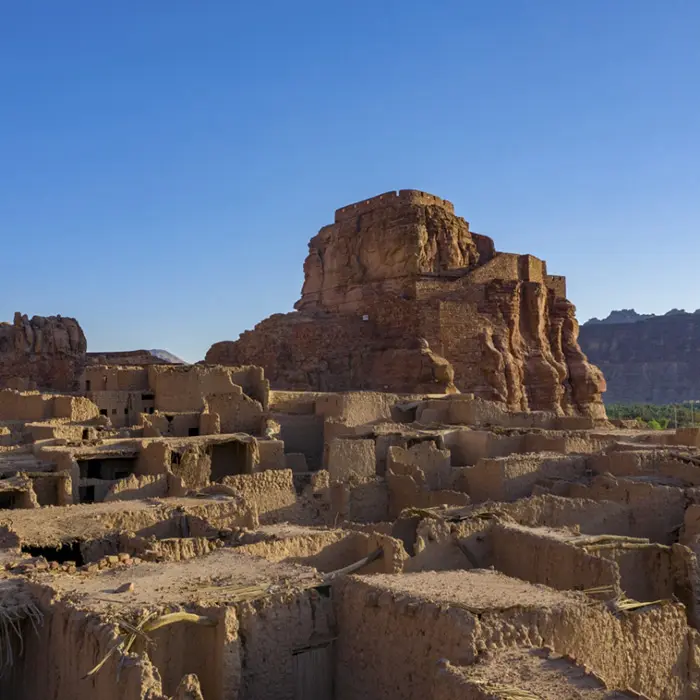The Middle East, where many old civilizations were born, has a lot of historical treasures that show us what life was like in the past. These places – from big monuments to detailed objects – demonstrate previous societies’ cleverness, culture, and artistry. In this article we will look at eight important historical treasures from Middle Eastern history; each one tells its special tale about heritage in that area.
The Pyramids of Giza, Egypt
The Pyramids of Giza are a wonder that shows the architectural skill of old Egypt. These huge buildings, made to be tombs for pharaohs, remain as some of the most known signs from ancient civilization. The biggest one called the Great Pyramid is an engineering marvel with its exact line-up and huge stone sections. The pyramids, which are a part of Giza’s complex, have a striking impact on visitors. They appear to be even more grand and significant up close than from far away. The mysterious aspects hidden within these structures such as detailed tombs and chambers often leave people in awe. Other elements in the necropolis like smaller pyramids and the Sphinx add to its historical importance
Petra, Jordan
With stunning carvings on rose-red rocks, Petra is an archaeological marvel that fascinates people with its incredible charm and historical importance. This olden Nabataean city, concealed in the mountains of southern Jordan, has grand buildings like the Treasury (Al-Khazneh), Monastery (Al-Deir), and Royal Tombs. Positioned on old trade paths, Petra turned into a busy city during its best times. Nowadays, it is a UNESCO World Heritage site that presents the past of Nabataean culture. The city’s complex water system and detailed rock-cut buildings reveal the cleverness of its people. Petra stays as one of Jordan’s favorite tourist spots, bringing people from all over to see its amazing scenery.
Persepolis, Iran
Persepolis, the Achaemenid Empire’s ceremonial capital, provides a glimpse into Persian architectural and artistic splendor. Darius the Great established this old city in 518 BCE; it features detailed bas-reliefs, mighty palaces, and tall columns. The Apadana Palace is a prominent attraction in Persepolis with its magnificent stairway and detailed carvings. Even after being damaged by Alexander the Great, the remaining parts of Persepolis still give a feeling of wonder and respect. The reliefs that show different groups of delegates highlight the empire’s wide area and mix of people from various nations. Persepolis is an important symbol for Persian culture, and it shows how much the Achaemenid Empire accomplished.
AlUla, Saudi Arabia
This place in the northwest region of Saudi Arabia holds many historical marvels. This ancient city was an important center on the incense trade path connecting Arabia with Egypt and the Mediterranean. One of its notable features includes rock-cut graves from Nabataean town named Hegra which are quite fascinating to see. You can learn about the burial customs of Nabataeans from these tombs, which are beautifully decorated with carvings. You can explore AlUla by visiting the Living Museum, which provides a unique opportunity to experience the region’s rich history and cultural heritage. The natural beauty of the city’s landscapes, such as its amazing rock shapes and green oases, also makes it more charming.
Babylon, Iraq
The city of Babylon, which is known as a symbol of the richness and strength of the Neo-Babylonian Empire, was among the most renowned towns in ancient times. This place – near to what we now call Baghdad – had Hanging Gardens that are famous worldwide too: these were one part of the Seven Wonders of the Ancient World. The Ishtar Gate, with its bright blue glazed bricks and images of legendary creatures on it, is an eye-catching remains from past grandeur in the Babylon area. Digging activities persistently show the complicated design of the city, big palaces, and temples that are devoted to gods such as Marduk. Present attempts for safeguarding and fixing up Babylon hope to recover its historical and cultural heritage.
Jericho, Palestine
Jericho, also known as the “City of Palms,” is among the most ancient cities still occupied today. It rests in the Jordan Valley and its history can be traced back to the 10th millennium BCE. The archaeological site Tell es-Sultan shows many layers of the past, starting from prehistoric settlements up until the Bronze Age city. The walls of Jericho, which were constructed approximately in 8000 BCE, can be considered as among the very first defensive structures. Jericho is a city with an old history and an important place. Its ancient ruins provide valuable insights into early urban development and human resilience.
Palmyra, Syria
Palmyra, a city from ancient times in the Syrian desert, was full of life and culture. It was also known as the “Bride of the Desert.” The large architecture of Palmyra shows an interesting mix between Greco-Roman, Persian, and local styles. Some famous places are the Temple of Bel, the Roman Theater, and streets with columns. Even with recent conflict causing harm, there’s work being done to save and revive Palmyra’s heritage which emphasizes its lasting importance. The city’s art and architecture display a diverse mix of cultural influences. Palmyra is an embodiment of Syria’s historical legacy, showing stories about strength and cultural fusion.
Byblos, Lebanon
Byblos is an important place in the history of Phoenicians. It’s located on the coast of the Mediterranean Sea and it played a crucial part in developing the Phoenician alphabet which later influenced modern writing systems. In Byblos, there are many archaeological treasures like old temples, royal tombs, and also a castle from the Crusader times. The harbor in Byblos is very attractive, with its old buildings and lively cultural life. It was once a main point for sea trade, linking the Mediterranean Sea to faraway countries. Byblos has long been recognized for its cultural importance, as it is one of the UNESCO World Heritage sites.
The old-time riches of the Middle East show us a picture of the past civilizations that created this region and also impacted world history. By studying these areas we can better understand our human story, appreciating the cleverness, creative work, and strength shown by societies that had flourished long ago.



